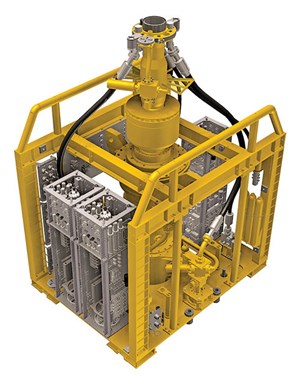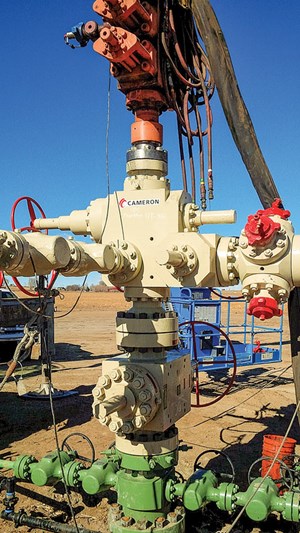New Cameron systems address subsea and horizontal well challenges
HIGH-AVAILABILITY BOP CONTROL SYSTEM
A subsea control system’s point of distribution (POD) is the component by which blowout preventers and other parts of the subsea stack are operated, often at water depths of 12,000 ft. Cameron’s new Mark IV High-Availability (HA) BOP control system—the industry’s first three-POD design—increases subsea-control system availability by up to 98%, Fig. 1. For operators, this offers greater protection against downtime resulting from adherence to standard practice, which demands that the entire stack be pulled if one POD fails on two-POD control systems. Any BOP stack retrieval to repair a malfunctioning POD can be particularly costly for deep- or ultra-deepwater projects. Accordingly, Cameron has added a third POD to its Mark IV two-POD BOP control system design.

To allow for weight and size restrictions imposed on equipment used offshore, the Mark IV POD design is 26% smaller than its predecessor, and 33% lighter than other PODs. Beyond its redundant design, the control POD has 50% fewer tubing connections to reduce the potential for leak paths. Also, it has redundant-solenoid pilot regulators to reduce single-point failures within the POD.
The number of functions on each of the PODs has been increased to 160, enabling it to accommodate eight-cavity stacks. The new POD is also designed with pressure-compensated pilot accumulators that adjust automatically to water depth, eliminating costly manual depth-setting errors. (Also see “OTC Spotlight on New Technology Awards,” page 161.)
FRAC TREE FOR HORIZONTAL WELLS
Cameron has introduced the F-T90, the first horizontal frac tree specifically suited for multi-well pad drilling and SIMOPS applications. This approach takes the reliable, conventional frac tree and repackages it to specifically fit the manner in which operators drill and complete unconventional wells. The F-T90 horizontal frac tree features an unconventional design that lowers the center of gravity while maintaining the same pressure rating and integrity of a conventional frac tree, Fig. 2.

Evolutionary history. Frac tree designs have been evolving toward composite block frac designs. Some designs have incorporated master and swab valves, and wing outlets into a solid body, reducing height and weight. Others have focused on creating a shorter assembly.
Cameron’s F-T90 frac tree offers significant improvements that promote safer operations and improved rig-up time. While other suppliers stopped design changes with the composite frac tree, Cameron has taken design improvements further with the design of an even shorter assembly. This F-T90 design offers an ultra-compact footprint, reduces height, and reduces bending stress at the tree connection. It can be operated with pneumatic, hydraulic or electric actuation, and can to handle 15,000 psi.
For a 5 1/8-in., 15,000-psi system, the horizontal tree is more than 50% smaller, and about 25% lighter than Cameron’s conventional frac tree. The F-T90 is short, stable and easily anchored.
Efficiency and reliability. Built to minimize the bending moments often induced by fracturing operations, the new horizontal tree has a substantially reduced moment arm that minimizes the bending stress that is experienced at the tree connection of a traditional tree.
There is also an internal buffer zone to help offset erosion. The tree is designed with an integrated cross for flowback and pump-down. A 625 inlay on seat pockets and ring grooves offsets corrosion.
On a two-man job, the F-T90 tree requires only one connection and one hour to nipple-up, rig up hoses and test. By comparison, on a conventional tree, three connections need to be made, requiring a 4-hr nipple-up, rig-up and test time. ![]()
- Advancing offshore decarbonization through electrification of FPSOs (March 2024)
- Subsea technology- Corrosion monitoring: From failure to success (February 2024)
- Driving MPD adoption with performance-enhancing technologies (January 2024)
- Digital transformation: A breakthrough year for digitalization in the offshore sector (January 2024)
- Offshore technology: Platform design: Is the next generation of offshore platforms changing offshore energy? (December 2023)
- 2024: A policy crossroads for American offshore energy (December 2023)


